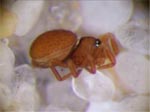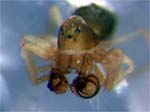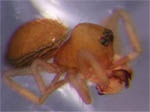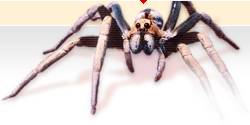
Micropholcommatid Spiders
Micropholcommatidae Hickman, 1943
(compiled by Michael G. Rix, with photographs by the author)
Identification
 opens in new window
opens in new window
Western Australia
Micropholcommatid spiders are very small in size (usually less than 1.5mm in body length), and variously black, brown, tan, yellowish or cream in colour. They possess a smoothly raised pars cephalica (head region) bearing eight, six or (rarely) no eyes and relatively few hairs. The anterior book lungs are reduced to anterior tracheae, and a posterior tracheal spiracle is usually absent. The abdomen is oval or spherical in profile, with an anterior sclerite surrounding the petiole (anterior to the epigastric furrow), and a posterior sclerite encircling the spinnerets; the abdomen is usually also covered by a dorsal scute and ventral or lateral scutes. The male pedipalp is either small and relatively simple, or large and complex, often with a long curled or coiled embolus. The patella of the male pedipalp is enlarged and armed with at least one apophysis. In many taxa, the female pedipalp is reduced to only four segments or to a single �nubbin� on the maxilla.
Biology
 opens in new window
opens in new window
Micropholcommatid spiders live within moss, thick leaf litter or under rocks and rotting logs in forested habitats; some troglobitic taxa also occur within caves (e.g. Olgania species in Tasmania). All appear to be restricted to consistently humid microhabitats, and the greatest diversity of species exists in temperate rainforests and wet sclerophyll forests. Very little is known of the biology of Micropholcommatidae, although some taxa probably build small webs with which to capture prey. In some areas they can be found in very large numbers in moss and wet leaf litter, although several species survive in semi-arid habitats.
Micropholcommatidae in Australasia
 opens in new window
opens in new window
Thirty micropholcommatid species in six genera have been described from Australasia, although many new species and genera are currently awaiting description (Rix, work in progress). There are also three species in two genera described from South America, and undescribed species are known from New Caledonia and Fiji.
Australia
Fourteen micropholcommatid species in four genera are described from Australia, most from Tasmania and Victoria:
- Eterosonycha alpina Butler, 1932 (New South Wales)
- Micropholcomma bryophilum (Butler, 1932) (Victoria)
- Micropholcomma caeligenum Crosby & Bishop, 1927 (Victoria)
- Micropholcomma longissimum (Butler, 1932) (Victoria)
- Micropholcomma mirum Hickman, 1943 (Tasmania)
- Micropholcomma parmatum Hickman, 1943 (Tasmania)
- Micropholcomma turbans Hickman, 1981 (Tasmania)
- Olgania excavata Hickman, 1979 (Tasmania)
- Textricella complexa Forster, 1959 (New South Wales)
- Textricella fulva Hickman, 1945 (Tasmania)
- Textricella hickmani Forster, 1959 (Tasmania)
- Textricella lamingtonensis Hickman, 1959 (South-eastern Queensland)
- Textricella luteola Hickman, 1945 (Tasmania)
- Textricella parva Hickman, 1945 (Tasmania)
New Zealand
Fifteen micropholcommatid species in three genera are described from New Zealand:
- Parapua punctata Forster, 1959
- Pua novaezealandiae Forster, 1959
- Textricella antipoda Forster, 1959
- Textricella aucklandica Forster, 1955
- Textricella insula Forster, 1959
- Textricella mcfarlanei Forster, 1959
- Textricella nigra Forster, 1959
- Textricella plebeia Forster, 1959
- Textricella propinqua Forster, 1959
- Textricella pusilla Forster, 1959
- Textricella salmoni Forster, 1959
- Textricella scuta Forster, 1959
- Textricella signata Forster, 1959
- Textricella vulgaris Forster, 1959
- Textricella wisei Forster, 1964
New Guinea
Only a single micropholcommatid species is described from New Guinea:
- Textricella tropica Forster, 1959
South-east Asia
Micropholcommatid spiders are not known from South-east Asia.
References
Forster, R. R. (1955). Spiders from the subantarctic islands of New Zealand. Records of the Dominion Museum 2: 167-203.
Forster, R. R. (1959). The spiders of the family Symphytognathidae. Transactions of the Royal Society of New Zealand 86: 269-329.
Forster, R. R. and Platnick, N. I. (1984). A review of the archaeid spiders and their relatives, with notes on the limits of the superfamily Palpimanoidea. Bulletin of the American Museum of Natural History 178: 1-106.
Forster, R. R. and Platnick, N. I. (1986). On Teutoniella, an American genus of the spider family Micropholcommatidae (Araneae, Palpimanoidea). American Museum Novitates 2854: 1-9.
Hickman, V. V. (1943). On some new Australian Apneumonomorphae with notes on their respiratory system. Papers and Proceedings of the Royal Society of Tasmania 1943: 179-195.
Hickman, V. V. (1945). A new group of apneumone spiders. Transactions of the Connecticut Academy of Arts and Sciences 36: 135-148.
Hickman, V. V. (1979). Some Tasmanian spiders of the families Oonopidae, Anapidae and Mysmenidae. Papers and Proceedings of the Royal Society of Tasmania 113: 53-79.
Hickman, V. V. (1981). New Tasmanian spiders of the families Archaeidae, Cycloctenidae, Amaurobiidae and Micropholcommatidae. Papers and Proceedings of the Royal Society of Tasmania 115: 47-68.

